
- Call : + 07523 300822
- Email : team@herefordshireurology.co.uk

Kidney Blockage

A kidney blockage means that the kidney is unable to do its job i.e. to get rid of toxic chemicals from the body. If the other kidney is working well this may not make a person feel unwell but could cause pain. If the blocked kidney is the only functioning kidney, or if both kidneys are blocked, this can lead to kidney failure.
The kidneys may be blocked at any point from the kidney to the urethra (the water pipe from the bladder to the outside world). Above the bladder the commonest cause of blockage is a kidney stone lodged in the ureter. Below the bladder the commonest cause of obstruction is an enlarged prostate in men and a narrow water pipe (urethra) in women. Obstruction can be caused by cancers, scarring and inflammation at any point in the urinary tract.
Treatment depends on the cause of the blockage and the problems that the blockage is causing. This could mean a catheter into the bladder to overcome an enlarged obstructive prostate or a tube into the kidney (either internally a stent or external – a nephrostomy) to directly drain the kidney. These tubes are generally only a temporary solution (although they can be used long-term) and ideally if possible the underlying cause of the blockage needs treatment.
Kidney Cancer

The number of kidney cancers reported around the world is rising, the cause of this remains unclear.
Approximately 8000 cases of kidney cancer are diagnosed each year in the UK with 3800 deaths. Often it causes no symptoms, nowadays a large proportion of kidney cancers are diagnosed incidentally due to the use of ultrasound or CT scanning being organised to look for other conditions. They may cause the following problems:
Haematuria: (Blood in urine)- this may be visible or non visible. Non-visible blood may be picked up by a simple urine dipstick test. The bleeding may be intermittent. It is important to realise that blood in the urine does not necessarily mean cancer, but the possibility of cancer must be excluded by performing appropriate tests.
Rarely a lump can be felt in the kidney area. This is an unusual presentation of kidney cancer, if a lump is detected it should be brought to your doctors attention for further investigations.
Vague symptoms: tiredness, anaemia (low blood count), weight loss, loss of appetite, high temperature or sweats. These symptoms can be caused by a wide variety of conditions and only rarely by kidney cancer (usually only in the advanced stages of kidney cancer).
If you are worried about the possibility of kidney cancer for whatever reason consult your doctor often either a simple ultrasound scan or sometimes a more in depth CT scan can be very helpful in diagnosing the problem.
Treatment for kidney cancer
Although Mr Nayar no longer routinely performs kidney cancer surgery he can advise you on the most appropriate treatment and refer you on to a colleague.
Treatment for kidney cancer depends upon how early it has been detected (i.e. the stage of the cancer). If diagnosed early enough the most commonly performed treatment is surgical removal of the kidney (nephrectomy). This can now be done commonly using keyhole surgical techniques (laparoscopic nephrectomy).
In some cases it may be possible to remove just the kidney cancer, leaving behind the healthy functioning kidney (partial nephrectomy).
If the cancer has spread, then surgery alone may not be able to cure the cancer, in which case Mr Nayar would discuss various treatment options including surgery and possible chemotherapy.
Kidney Infections
Kidney infections or pyelonephritis can be a serious and debilitating disease. It is more common in women and in those that get recurrent urinary tract infections. They can occasionally cause severe infections that can necessitate admission to hospital for antibiotics into a vein. Important problems such as kidney obstruction need to be excluded to allow effective recovery. Mr Nayar will carefully assess your symptoms and manage these infections to reduce the chances of recurrent infections.
Kidney Stones

Human kidneys get rid of various unwanted salts dissolved in the urine. Occasionally these salts form crystals and then stones form within the kidney.
Kidney stones are a fairly common problem, it is estimated that in the United Kingdom approximately 1 in 10 men and 1 in 20 women will get problems with a kidney stone within their lifetime. The stones are formed within the kidneys and either stay there not causing symptoms, or they can grow in size and cause problems. Alternatively the stones can drop out of the kidney into the drainage tube between the kidney and the bladder (called the ureter) and cause ureteric colic. This presents as intense pain which comes and goes in waves radiating from the renal angle to the groin. The pain from renal colic is said to be one of the worst pains known to mankind, the kidney can become blocked and often emergency admission to hospital is required. Blockage of the kidney can lead to damage to the kidney in the long term if not treated. stones can also cause blood in the urine and infections.
The gold standard test to diagnose kidney stones is a CT scan.
Treatment of kidney stones
The treatment of kidney stones depends upon the size and position of the stone. The majority of stones require no surgical treatment as they are either small or not causing problems, or they make their way out spontaneously. Kidney stones that move usually pass through the ureter within a couple of days and initial treatment may just include strong pain relief.
There are various treatment options for stones that are of a significant size and remain within the kidney or those that become stuck in the ureter. These include:
Shockwave treatment- this uses sound waves to break the stones into small fragments which then can be passed spontaneously. This is performed with the help of a machine and is called extracorporeal shock wave lithotripsy.
Surgical treatment- either by key hole surgery of the kidney (percutaneous nephrolithotomy) or by telescope surgery through the water pipe (ureteroscopy).